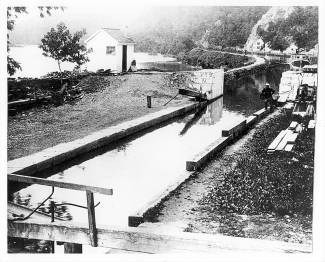Collection Name
About
A berm is apparent at the upper end of this lock, resulting in the upstream gate part of the lock being raised higher than the top of the lock and the towpath going over the berm. Such a berm would have provided some protection to the lock and the canal below it when flood waters rose to the towpath level upstream from the lock. However, the berm is not high enough to provide much protection if the flood was a large one. The small white building between the towpath and the river is a lock shanty and it provided the locktender protection from the weather as well as a place to rest. Locks were operated 24-hours a day and thus a shanty in which a cot could be kept and often a stove for preparing meal s or providing heat was a necessity.
In 1875 John Winter & Bro. dealt in Flour, Feed and Grain at Lock No. 33 ( Boyd's Business Directory, 1875, and Marsha Walsh had a variety store ( Boyd's Business Directory, 1875).
Mile 60.7
A lock is a chamber used to lift or drop water levels in order for a boat to move across elevation levels. There are 74 lift locks that rise 605 ft from Georgetown to Cumberland. The locks were tended by lockkeepers that would operate the locks for the canal boats that would arrive at any time of the day on their way either to Georgetown or Cumberland. Materials used to build the locks ranged from Aquia Creek Freestone, Granite, and Seneca stone to wood and cement on the upper composite locks. The locks would also be a place for canallers to trade or buy supplies that they would need for their long journeys.
